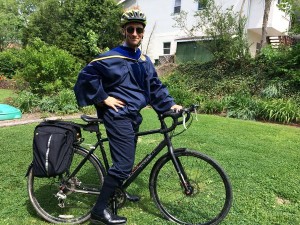Last week, I wrote a short blog highlighting a publication in this month’s issue of Injury Prevention which stressed the need to gather “better” data as a step towards improving future bicycle safety endeavors.
This week, I am absolutely delighted to introduce a guest blog by someone who is equally passionate and enthusiastic about data as he is about bicycle safety – my mentor and inspiration, Dr. Christiaan Abildso (follow him on Twitter at @walkbikemgw)! He is an assistant professor in the Department of Social and Behavioral Sciences at WVU School of Public Health. His main areas of research include health promotion program evaluation and the social ecological determinants of physical activity, including policy and the built environment. Recently, he presented “The Burden of Pedestrian- and Cyclist-Motor Vehicle Crashes (PCMCVs) and Costs in West Virginia: 2000-06” as a part of the 2014 WVU Injury Control Research Center’s webinar series (you can watch it here).

Christiaan has two very notorious and very utlized catchphrases; the first is “I love data!” and the second is “Change the world!” which he very well does by engaging in the community. He served as the Chairperson for the Morgantown Pedestrian Safety Board from 2008 to 2014, has been an Ex-officio Member of the Morgantown Municipal Bicycle Board since 2012, and is a current member of both the West Virginia Connecting Communities and the Morgantown Traffic Commission.
Since this month’s blogging topic was to be focused on bike safety, I asked Christiaan to write a guest blog about his own experience as he transitioned from a novice cyclist to a trained traffic rider.
“Drive Your Bike, Don’t Just Ride It”
By guest blogger: Christiaan Abildso
My first taste of freedom was experienced on a teal-green Peugeot in the mid-1980s in suburban Washington DC. With each passing summer and my super cool 5-speed, I was given more and more leeway by my parents to “ride to John’s house,” then to Tom’s house, then to the community pool and parks. As a young lad in pre-helmet days I had a great time riding on and off sidewalks, and on wide streets mostly of 25 mph speed limit. It was suburban America in a Levitt town in the summer. I was safe.
As I grew up I rode less or not at all until I got back into bicycle commuting about 6 years ago when I became a father, gas prices were high, and I didn’t have time to go to a gym. I began to experience that freedom yet again. However, I was now riding in a more urban environment with more traffic, narrower lanes, no bike lanes or separate infrastructure, and less kindness toward me as a cyclist – let’s face it, kids on bikes get more leeway to mess up than mid-thirties cyclists! One day, I moved from the end of 5 cars at a red light in the left lane in a three lane, one-way downtown road to the middle lane to be at the front of the traffic. I did this to jump the traffic and move back over in front of the left lane traffic to make a turn. As I jumped back to the left lane, a kind gentleman driving by leaned his Livestrong band covered left wrist and wagged a finger at me, saying “you should know better. You’re gonna get killed.”
This statement made me think, what did I do wrong? That moment began my evolution from thinking like a “bike rider” to thinking like a “bike driver.” I began seeking the opinion of Frank Gmeindl – a League of American Bicyclists certified League Cycling Instructor (LCI) in Morgantown, WV, and uber-experienced rider with tens of thousands of miles of experience. He offered to ride behind me one day giving only these instructions (as I recall them): 1) ride like a vehicle, 2) be predictable, 3) be seen, and 4) take the lane. Following the ride – during which, in retrospect, I did a bunch of things that put me in harm’s way (like riding as far to the edge of the road as possible) – Frank patiently offered these same four suggestions, then took the lead. His few suggestions have, without a doubt, saved my life.

I continued to seek out information, eventually taking the Safer City Cycling class offered by Frank and another local LCI. I have ridden thousands of miles over the past few years with the advice of Frank and others in my head. I now am confident enough in my abilities to ride in almost any condition on nearly any road without fear. Over the years I have evolved to be very calm in traffic and now help others when I see them riding in a way that puts them (or me as “one of those pesky bikers”) at risk of injury. I honed in on one statement I heard or read a few years back that summarizes how to operate a bicycle: “Drive your bike, don’t just ride it.” That neatly summarizes Frank’s four key lessons, and I often use that with others when they say I’m crazy for riding all the time and on almost any road. I also make an offer to them, as Frank did, to go for a ride to help.
To my fellow cyclists, when in traffic. Remember, we are traffic. We are adults. Vehicle drivers don’t want to hit us.
My advice when in traffic: Be seen. Be predictable. Take the lane. Drive your bike like you would a car…and, give a hand of thanks when a vehicle driver treats you well. It will make driving a bike safer for all of us.
Follow Dr. Christiaan Abildso at @walkbikemgw!